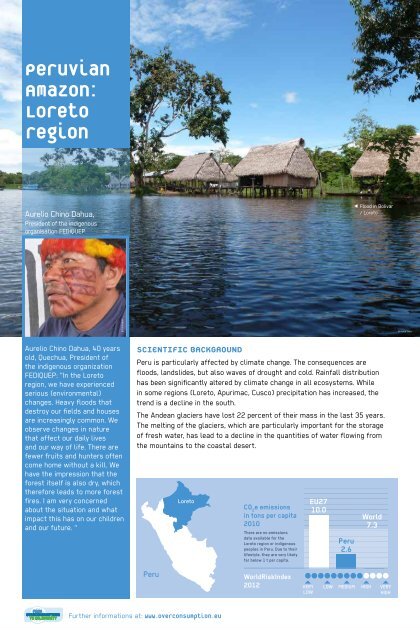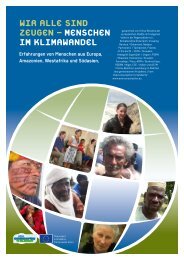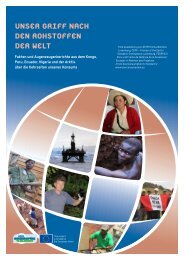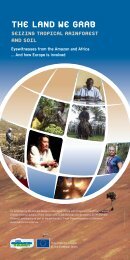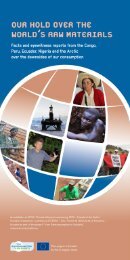WE ARE ALL WITNESSES - PEOPLE IN A CHANGING CLIMATE
The 24 panels of the "We are all witnesses - People in a Changing Climate" exhibition illustrate how climate change is already taking place in 16 countries in four countries.
The 24 panels of the "We are all witnesses - People in a Changing Climate" exhibition illustrate how climate change is already taking place in 16 countries in four countries.
Create successful ePaper yourself
Turn your PDF publications into a flip-book with our unique Google optimized e-Paper software.
Peruvian<br />
Amazon:<br />
Loreto<br />
region<br />
Aurelio Chino Dahua,<br />
President of the indigenous<br />
organisation FEDIQUEP<br />
Flood in Bolivar<br />
/ Loreto<br />
© FORMABIAP<br />
© Astrid Sieler<br />
Aurelio Chino Dahua, 40 years<br />
old, Quechua, President of<br />
the indigenous organization<br />
FEDIQUEP: “In the Loreto<br />
region, we have experienced<br />
serious (environmental)<br />
changes. Heavy floods that<br />
destroy our fields and houses<br />
are increasingly common. We<br />
observe changes in nature<br />
that affect our daily lives<br />
and our way of life. There are<br />
fewer fruits and hunters often<br />
come home without a kill. We<br />
have the impression that the<br />
forest itself is also dry, which<br />
therefore leads to more forest<br />
fires. I am very concerned<br />
about the situation and what<br />
impact this has on our children<br />
and our future. “<br />
SCIENTIFIC BACKGROUND<br />
Peru is particularly affected by climate change. The consequences are<br />
floods, landslides, but also waves of drought and cold. Rainfall distribution<br />
has been significantly altered by climate change in all ecosystems. While<br />
in some regions (Loreto, Apurimac, Cusco) precipitation has increased, the<br />
trend is a decline in the south.<br />
The Andean glaciers have lost 22 percent of their mass in the last 35 years.<br />
The melting of the glaciers, which are particularly important for the storage<br />
of fresh water, has lead to a decline in the quantities of water flowing from<br />
the mountains to the coastal desert.<br />
Peru<br />
Loreto<br />
CO 2<br />
e emissions<br />
in tons per capita<br />
2010<br />
There are no emissions<br />
data available for the<br />
Loreto region or indigenous<br />
peoples in Peru. Due to their<br />
lifestyle, they are very likely<br />
far below 1 t per capita.<br />
WorldRiskIndex<br />
2012<br />
15<br />
14<br />
13<br />
12<br />
11<br />
10<br />
9<br />
8<br />
7<br />
6<br />
5<br />
4<br />
3<br />
2<br />
1<br />
0<br />
VERY<br />
LOW<br />
EU27<br />
10.0<br />
Peru<br />
2.6<br />
World<br />
7.3<br />
LOW MEDIUM HIGH VERY<br />
HIGH<br />
Further informations at: www.overconsumption.eu


